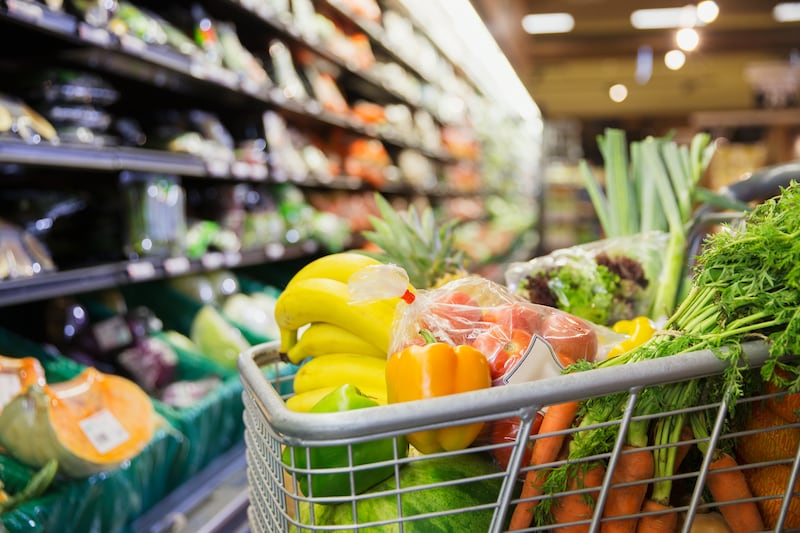Given the widely advertised boasts about dramatic price cuts up and down their aisles from some of Ireland’s leading supermarkets in recent months, you would be forgiven for thinking the cost of living crisis was over or at least coming to an end.
That could scarcely be further from the truth.
While there has undoubtedly been some downward price pressure on some products in recent weeks, retail analysts are quick to highlight the harsh reality of grocery prices that remain dramatically higher than at the start of last year.
Since April 2022, The Irish Times has been tracking the price of a basket of commonly bought goods. When we started, we put the price of the basket at €78.36.
READ MORE
The same products have climbed to €94.43 this week, an increase of 20.5 per cent. Spread over the course of a year, the higher cost amounts to €835. And prices are still climbing fast.
This is the third month in a row where there has been a drop in grocery inflation, which is welcome news for Irish consumers, although the rate is still incredibly high
— Emer Healy, business development director of retail analyst Kantar
The cost of groceries went up by just under 13 per cent in the 12 months to the start of August, according to figures from retail analyst Kantar published earlier this week.
While the double-digit price increases will heap more financial pressure on households, the data could almost be framed as good news, with the rate of grocery inflation falling by almost two percentage points since last month and by close to four percentage points since May.

“This is the third month in a row where there has been a drop in grocery inflation, which is welcome news for Irish consumers, although the rate is still incredibly high,” says Kantar’s business development director Emer Healy.
‘Gradual decline’
She says the current rate of grocery inflation is the lowest level Kantar has recorded in almost a year and she expects “to see a continued gradual decline in inflation rates over the coming months.”
But gradual declines aside, many – if not all – Irish households will still spend an additional €1,000 or more on groceries over the next 12 months than they did in 2020, with the chances of prices falling to pre-crisis levels in the short, medium or even longer term put at zero.
While Damian O’Reilly, a retail analyst and TU Dublin academic, acknowledges the “downward pressure” on prices in recent months he warns that the era of cheap food is gone.
He suggests that the fall in the price of some products has been driven by retailers in a position to pass on input cost reductions, including cheaper energy and transportation, to consumers.
But he warns that the pressure on retailers is still intense and they are operating under the slimmest of profit margins.
He points to a recent investigation from the Competition and Consumer Protection Commission (CCPC), which largely exonerated the Irish grocery sector of charges that it was artificially inflating prices in order to maximise profits.
Across the EU, grocery prices have climbed by an average of close to 30 per cent, with prices in Ireland up around half of the average
The CCPC investigation was carried out at the request of the Minister for Enterprise Simon Coveney earlier this summer as calls for supermarkets to act faster to lower prices grew louder.
The analysis found that there was no evidence of excessive price hikes and noted that food inflation in Ireland has actually been the lowest in the EU in recent years.
Giant multinationals
Across the EU, grocery prices have climbed by an average of close to 30 per cent, with prices in Ireland up around half of the average.
But retailers and their pricing models are only one part of the puzzle, with the giant multinationals that stock so many of Ireland’s supermarket shelves making up a considerably larger part of it.
A cursory glance at the recent comments of some of the biggest players in that space might give reason for hope.
At the start of this month, Kerry Group said it expected its input costs to fall in the second half of the year. The food group’s chief financial officer Marguerite Larkin said that while its taste and nutrition division saw “double-digit” input cost inflation in the first half of the year, Kerry was forecasting “modest deflation” in the second half.

“Here’s the good news – the pricing is done,” said Miguel Patricio, the chief executive of food giant Kraft Heinz, earlier this month.
I don’t see any significant downward pressure coming. We are not going to see the low prices we saw before and the prices that we saw over the last 15 years, we are not going to see again
— Damian O'Reilly, retail analyst
Nestlé's chief executive Mark Schneider said price hikes would ease for the rest of this year while his counterpart in Danone, Antoine de Saint-Affrique, said the rate at which prices will climb “will be decreasing as we go through the next quarter”. Unilever’s chief financial officer Graeme Pitkethly suggested that “we have passed peak inflation”.
[ Nestlé sales advance on higher prices for KitKats and pet foodOpens in new window ]
This is obviously welcome news for Irish consumers but it would be a mistake to think these rosy assessments mean the savage price hikes imposed over the past 18 months will be reversed.
Turn for the worse
If anything, Damian O’Reilly suggests, things could take a turn for the worse in the medium term as a result of global supply-chain issues and geopolitical unrest and war in eastern Europe.
He says the best Irish consumers might be able to hope for over the next five years will be inflation of 3 per cent. “I don’t see any significant downward pressure coming. We are not going to see the low prices we saw before and the prices that we saw over the last 15 years, we are not going to see again.”

He suggests that instead there are likely to be “moderate price increases on top of what we have seen over the last 18 months.”
O’Reilly also points to a very uncertain future at home and abroad which will see the consequences of climate change and the more transitory impacts of El Nino putting pressure on global markets.
“I think we are going to see food security become more of an issue in the future,” he says.
He points to the ongoing war in Ukraine and the impact it is having on the production of key food items such as sunflower oil, and ongoing uncertainty over supplies of wheat from what was long regarded as the bread basket of Europe. And he highlights how concerns over production and climate change have prompted the Indian government to impose restrictions on rice exports.
“Global volatility will be reflected in higher input costs in three to five months,” he suggests. “And when there is higher input costs there will be more pressure on prices for consumers.”
Geopolitical forces
Some of the pressure comes from geopolitical forces outside of Ireland’s control but, O’Reilly says, other pressures are a result of internal decisions.
The increased rate of VAT across the hospitality sector from 9 per cent to 13.5 per cent as well as likely increases to the minimum wage will put greater pressure on the Irish food and hospitality sector.
“By the time you build in higher VAT and higher wages and higher input costs, you will see pressure on food prices because retailers will have to pass that on,” he says.



















